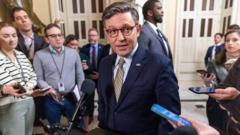### Ukraine's President Volodymyr Zelensky announced an alarming increase in military casualties, with estimates suggesting over 43,000 soldiers lost since the onset of the invasion, coinciding with broader political dialogues about peace and security.
### Ukrainian Casualty Figures Rise as Zelensky Reveals New Estimates

### Ukrainian Casualty Figures Rise as Zelensky Reveals New Estimates
### President's update highlights significant human cost of ongoing conflict amidst political dynamics with U.S. leadership.
In a rare and sobering update on the impact of Russia’s ongoing invasion, Ukrainian President Volodymyr Zelensky reported that approximately 43,000 Ukrainian soldiers have been killed since the start of the conflict. This acknowledgement came through a social media post, indicating a substantial rise in casualties from previous estimates. Alongside the death toll, he pointed to 370,000 injuries, although this figure includes multiple injuries to some soldiers and encompasses various severity levels.
Zelensky's announcement arrives against a backdrop of competing narratives regarding military losses. He alleged that Russian casualties stand at around 198,000 dead and 550,000 wounded, figures that align closely with estimates shared by Western government officials. However, both sides have faced scrutiny for their casualty figures, which remain unverified by entities such as the BBC.
The updated reports reflect a dramatic increase in Ukrainian military deaths since February, when the toll was placed at 31,000. Zelensky’s disclosure follows recent comments from U.S. President-elect Donald Trump, who claimed Ukraine had "ridiculously lost" around 400,000 soldiers. Trump's remarks underscore a shift in the narrative among certain U.S. factions, with calls for reconsideration of American support for Ukraine's military efforts.
War dynamics have intensified as Russian forces continue to make slight territorial gains in Eastern Ukraine, a change described as part of Russia’s "meat grinder" tactics. The UK's Ministry of Defence revealed that Russia experienced roughly 45,680 casualties in November alone, marking a significant uptick in losses as compared to earlier figures throughout the conflict.
Zelensky’s communication about troop losses was embedded within broader conversations regarding the potential for peace negotiations, emphasizing the necessity for robust international security assurances for Ukraine. After meetings with both Trump and French President Emmanuel Macron, he reiterated that any cessation of hostilities must offer long-term guarantees that could withstand future geopolitical threats from Russia.
The Kremlin has publicly contested Western and Ukrainian estimates of casualties, asserting that losses on their side are considerably lower. Additionally, they have presented their demands for any ceasefire, which involve Ukrainian territorial concessions and a rejection of NATO ambitions—a stance that Ukraine firmly opposes.
As the war grinds on, official discussions of peace seem to hinge on complex international dynamics and the overarching need for a resolution that ensures Ukraine's sovereignty and security in the face of continued aggression from Russia.
Zelensky's announcement arrives against a backdrop of competing narratives regarding military losses. He alleged that Russian casualties stand at around 198,000 dead and 550,000 wounded, figures that align closely with estimates shared by Western government officials. However, both sides have faced scrutiny for their casualty figures, which remain unverified by entities such as the BBC.
The updated reports reflect a dramatic increase in Ukrainian military deaths since February, when the toll was placed at 31,000. Zelensky’s disclosure follows recent comments from U.S. President-elect Donald Trump, who claimed Ukraine had "ridiculously lost" around 400,000 soldiers. Trump's remarks underscore a shift in the narrative among certain U.S. factions, with calls for reconsideration of American support for Ukraine's military efforts.
War dynamics have intensified as Russian forces continue to make slight territorial gains in Eastern Ukraine, a change described as part of Russia’s "meat grinder" tactics. The UK's Ministry of Defence revealed that Russia experienced roughly 45,680 casualties in November alone, marking a significant uptick in losses as compared to earlier figures throughout the conflict.
Zelensky’s communication about troop losses was embedded within broader conversations regarding the potential for peace negotiations, emphasizing the necessity for robust international security assurances for Ukraine. After meetings with both Trump and French President Emmanuel Macron, he reiterated that any cessation of hostilities must offer long-term guarantees that could withstand future geopolitical threats from Russia.
The Kremlin has publicly contested Western and Ukrainian estimates of casualties, asserting that losses on their side are considerably lower. Additionally, they have presented their demands for any ceasefire, which involve Ukrainian territorial concessions and a rejection of NATO ambitions—a stance that Ukraine firmly opposes.
As the war grinds on, official discussions of peace seem to hinge on complex international dynamics and the overarching need for a resolution that ensures Ukraine's sovereignty and security in the face of continued aggression from Russia.





















